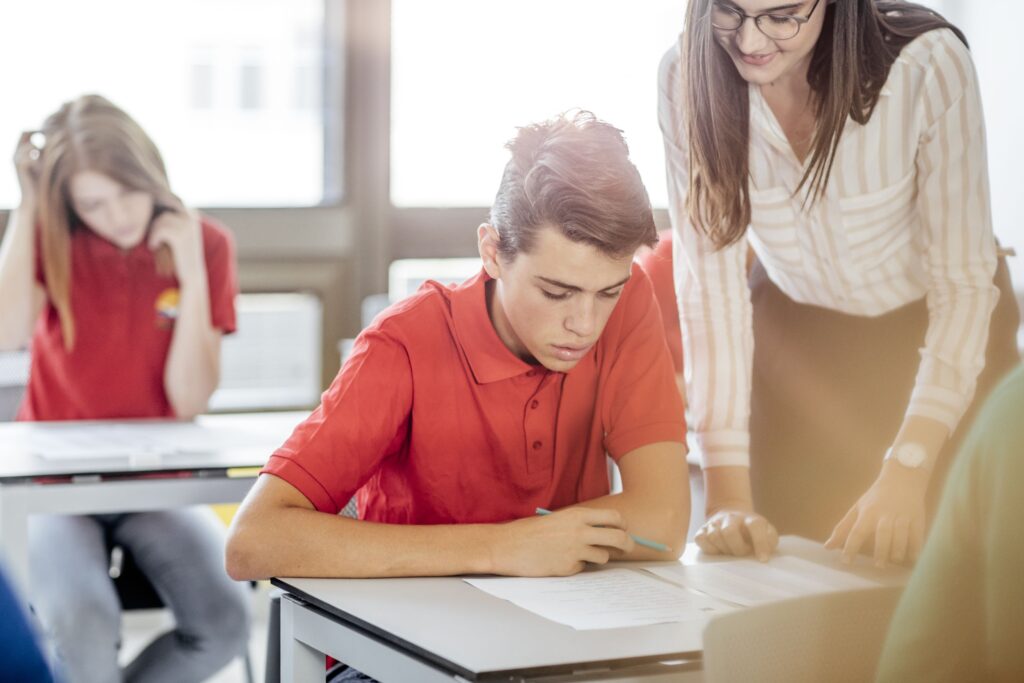An important part of any class is assessing students on the knowledge of the different topics and concepts that they have learned. Students can demonstrate their knowledge in many different ways such as through formative or summative assessments, a long or short-term project, or simply by having a class discussion and questions that they need to answer individually. All of these are ways that teachers can determine how little or how well students are understanding a topic. However, regardless of how students are assessed, they need to also be given critical feedback in one way or another. This is especially important for tests and summative assessments.
Classroom Discussion and Examination of Test Prompts
Possibly the best way to help students learn from their tests is to go over the tests with the students in class. While this might seem obvious, it does take some important steps to be executed correctly. To begin with, the test must be graded in a timely fashion. Now, for some disciplines, this might be a matter of course. For other disciplines, however, this could present a real challenge for the teacher.
An ELA teacher, for example, who assigns an essay component to the test might take longer to return the exams as opposed to say, a math teacher who may be able to use a scantron sheet to grade the majority of the test or who does not have as long of an assessment to grade. By reviewing the tests with all students, it provides immediate feedback and allows students to gain a better, more thorough understanding of the topics they were assessed on as well as the misconceptions they had with the material.
Once the tests are corrected and returned to the students, the teacher needs to take time going over each question, specifically focusing on those questions that had the most incorrect answers. Although this may be tedious and time-consuming, it is truly beneficial to the students. When going over the test, the teacher can have the students put all writing instruments away and have students simply listen and pay attention to the corrections.
Or the teacher may require that the students fill in the correct answers and make the corrections during the review of the test and remind students that many of the questions may appear again in the future such as on a midterm or final exam. This behooves students to not only write down the correct answers, but to also make sure they have a full understanding of why they may have answered incorrectly on the exam.
Go Over Answers as a Class
Another way students may learn from a test is for the teacher to point out the answers to certain questions that were revealed on the test itself. Oftentimes, by the nature of the exam, answers are embedded within the questions. Savvy students, with help, can begin to ascertain how to find many answers to test prompts that are often revealed in the test itself. Once the exam is handed back, a teacher can point out areas of the exam that reveal answers to other questions.
If a teacher models that strategy enough, a student may begin to learn how to find answers to difficult questions right under their very noses. This can help students to not only relearn the material that was assessed upon on the assessment but also to develop better critical reading or problem-solving skills. These skills will be used in the future and help prepare students for their next assessments.
Student Reflection
Another way teachers can help student learning from reviewing tests is by providing a reflection component of some sort to the review. A reflection component can help students to identify the errors they made and learn from those mistakes. Some teachers might do this reflection component by having students do corrections in which they will redo the components of the assessment in which they lost points. Some teachers might even give points back to the students for doing this, which could be a motivator for some students. Other teachers might assign test corrections as part of a homework assignment.
Either way, by having the students take a second look at their original work and compare to what they were taught and what they have in their notes can help them to learn from their mistakes – a major part of education and life. Other ways that students can reflect on work is by having them identify what they did incorrectly and what would have been correct. This could be discussed at a time with the teacher in an independent setting or done on a separate sheet of paper in a journal-style format. Again, having the student take a second glance can help them to recognize the few mistakes that they made or the misconceptions that they had.
Review Assessments with Students
Reviewing assessments with students helps them to not only understand the topics but also the overarching concepts and themes that will help them with future topics. By developing a strong skill sense, it helps the students to understand skills are needed as well as when and how to best apply them. It also helps students to continue to better themselves and their learning. Students can start to develop a sense of what works for them in preparing for an assessment and what does not.
By reviewing an assessment, students learn the course’s crucial aspects and what is needed to succeed. Students can, then, take this information and use it to better themselves and their learning while studying for the assessment. It can help students to create a game plan in which they are preparing as best as they can based on what they have learned in the chapter/topic area as well as from past assessments and assignments. Again, it allows students to reflect and learn from their mistakes.
The ultimate reason to review assessments with students is to provide critical feedback to help improve the students’ learning and performance in the class. Receiving feedback, whether positive or constructive, can help any person to gain a better understanding of what is right and what is wrong/what is good and what is bad. It is a way to help the students develop a sense of what they know and what they are missing as well as the in-between. It is a way for students to gain a better understanding of how they learn in each class and how to prepare in each class.
Reviewing formative and summative material with students helps them to retain the information better by constantly reviewing concepts that they will continue to use throughout the course. Reviewing helps students to understand what they have learned and continues to reinforce the learning as the course goes on.
Teachers never stop learning; check out our available graduate degree programs to hone your skills and promote lifelong learning and academic excellence.




